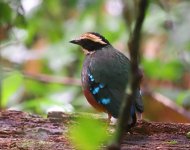When In Uganda will you be happy to tick this?

xeno-canto.org
I certainly wouldn't have. I wanted this. But everyone to their own.
Yes, I would tick the Pitta on call. Obviously, I would want to see it and to photograph it but I doubt that you really see much connection between the elements of your post.
To be blunt, being happy one way or the other or obsessing about the outcomes is a way to ensure misery out of positive experiences and privileges. I'll certainly ensure that I am not unhappy if I only hear the Pitta. Even if I do not hear it or see it or photograph it, I'll take the positives.
On a recent Peru trip, I recorded nine Antpittas - six photo'd, one seen only & two heard only. I thought quite hard and was quite miserable about the ones that I did not see or photo but to be blunt, that just indicated that I was a petulant child.
On my recent Thailand trip, I recorded four Pittas - three photo'd & one seen only. I kicked myself for fluffing the photo on the one that was seen only. But again to be blunt, that just indicated that I was a petulant child.
I should have been happy and privileged regardless. That does not mean that you diminish your efforts.
Two hours with a thermal to turn an Oriental Bay Owl calling into a sighting. Three nights' effort to see Mountain Scops Owl. So there you go. Merely because you would tick something on call does not mean that you do not want to maximise the experiences.
My best Pitta experience in Thailand was a territorial dispute between two Mangrove Pitta pairs when I had already heard, then seen and then photo'd the species on a previous day. It was still an upgrade on my previous experience with the species.
I will work out my life list at some point. I will also work out what I have seen and photographed. But the numbers to be blunt are irrelevant to me. I'll still want to photograph a Blue Pitta or improve my Oriental Bay Owl photo.
Back to sitting in the wet and cold with my moth traps...
All the best
Paul









